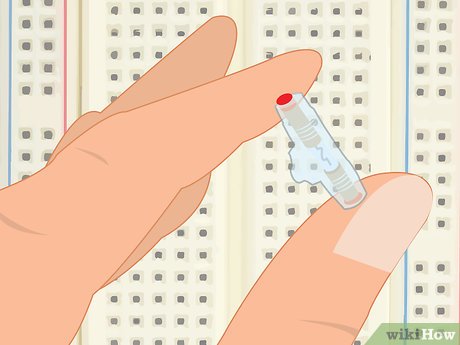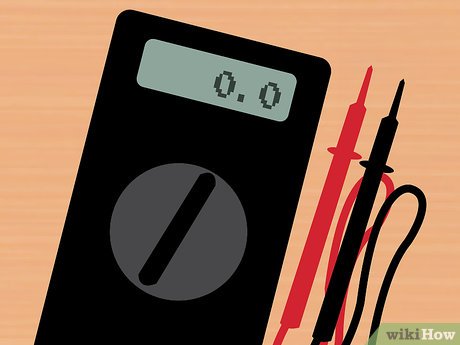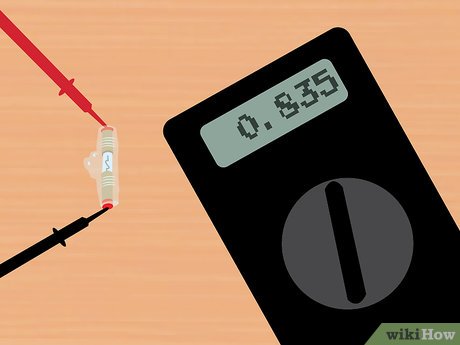How to Test a Fuse With a Multimeter
Part 1 of 2:
Learning about Fuses and Multimeters
-
 Understand fuses. Fuses are really just wires that are designed not to last, but their purpose is to prevent damage to more valuable electrical equipment or prevent fires (especially in homes) caused by power surges. If too much power runs through the fuse, it will "burn out," quite literally, and open the circuit, preventing the current from flowing through the circuit. There are several varieties of fuses, but their differences are primarily in appearance. Here is a description of the two you are most likely to see:
Understand fuses. Fuses are really just wires that are designed not to last, but their purpose is to prevent damage to more valuable electrical equipment or prevent fires (especially in homes) caused by power surges. If too much power runs through the fuse, it will "burn out," quite literally, and open the circuit, preventing the current from flowing through the circuit. There are several varieties of fuses, but their differences are primarily in appearance. Here is a description of the two you are most likely to see:- The cartridge fuse is a cylindrical fuse that has been common in a wide variety of devices for many years, from homes to small electronic devices. They have metal contact or terminal points on either end and consist primarily of a tube that contains the wire.[1]
- The blade fuse is a common type of automotive fuse that has come into use in the last 20-30 years. They vaguely resemble the plug of a power cord, with two metal prongs emanating from a plastic housing that contains the wire. Previously, most vehicles also contained small glass cartridge fuses. Blade fuses plug conveniently into banks, and relatively little space is required to house a large number of them together.[2]
-
 Learn how a multimeter works. Multimeters measure AC and DC voltage, electrical resistance, and the flow of current. For testing a fuse, you can either use it to measure the continuity (which tests if the circuit is complete) or the ohms (which tests resistance). [3]
Learn how a multimeter works. Multimeters measure AC and DC voltage, electrical resistance, and the flow of current. For testing a fuse, you can either use it to measure the continuity (which tests if the circuit is complete) or the ohms (which tests resistance). [3]- A multimeter has a positive and negative lead. When testing resistance in a circuit, the meter will transmit a small quantity of electricity from its own battery and then measure the amount that passes through the circuit or object.
-
 Understand why you must test fuses. Testing fuses is the simplest way to examine what is going on in the electrical systems of your car or home, and for that reason, it is a vital skill to possess.
Understand why you must test fuses. Testing fuses is the simplest way to examine what is going on in the electrical systems of your car or home, and for that reason, it is a vital skill to possess.- It is easier to test fuses than it is to test other electrical equipment. Other components in your car or home involve complex wiring systems that run on for some length. In addition, most car parts can only be tested at repair shops, and to do so will usually cost quite a lot of money. Testing fuses with a multimeter is comparatively simple to do, and the equipment involved is cheap and easy to operate.
- Many types of fuses allow for visual confirmation that the fuse is still functional. They are made clear so that you can see if the wire remains intact. If the translucent area is blackened, it is usually because the fuse has burned out. However, some fuses will create that blackened stain after only slightly overheating, and that may have even been the result of an unnoticed incident weeks or months earlier. If a device is not working, you should test the fuses. If the fuses are all still working, there is likely a more serious problem and it may be time to call on an expert.
Part 2 of 2:
Testing the Fuse
-
 Turn the equipment off and remove the fuse. Make sure the device, equipment, or vehicle is turned off before the fuse is removed. To remove the fuse, simply pull it straight out of the slot.
Turn the equipment off and remove the fuse. Make sure the device, equipment, or vehicle is turned off before the fuse is removed. To remove the fuse, simply pull it straight out of the slot. -
 Turn the meter on and set it to measure continuity. Turn the dial on the multimeter so it points to the continuity setting, which looks like 5 curved vertical lines. Before you test the fuse, put the positive and negative leads together and listen for the meter to beep to ensure it's working properly.
Turn the meter on and set it to measure continuity. Turn the dial on the multimeter so it points to the continuity setting, which looks like 5 curved vertical lines. Before you test the fuse, put the positive and negative leads together and listen for the meter to beep to ensure it's working properly.- If you want to measure the ohms, use the multimeter setting that has the omega symbol (Ω).
-
 Put one lead on each end of the fuse and look at the display. Because the fuse is little more than a single wire—and no complex parts to worry about—it does not matter which side receives the positive or negative lead.
Put one lead on each end of the fuse and look at the display. Because the fuse is little more than a single wire—and no complex parts to worry about—it does not matter which side receives the positive or negative lead. -
 Test the fuse. Listen for the multimeter to beep continuously as you hold the probes against the fuse. If you don't hear any noise coming from the meter, then the fuse is blown and should be replaced.
Test the fuse. Listen for the multimeter to beep continuously as you hold the probes against the fuse. If you don't hear any noise coming from the meter, then the fuse is blown and should be replaced.- If you're using a digital multimeter set to measure resistance, touch the probes together to get an initial reading. Then put the probes on either side of the fuse and check if the reading is similar. If it is, then the fuse works properly. If you get no reading or 'OL', then the fuse has blown.
4 ★ | 1 Vote
You should read it
- How to Measure Speaker Impedance
- How to manually check the computer source with a multimeter
- How to Use a Digital Multimeter
- How to fix a microwave oven that lost its signal due to a high-voltage fuse blown?
- Please download Google's Measure app, which supports all Android-compatible ARCore smartphones
- How to measure bra size at home
- Instructions for measuring heart rate by phone camera
- How to use distance measurement on iPhone
May be interested
- How to Measure Speaker Impedance
 a speaker's impedance is a measure of a device's ability to resist alternating current. impedance is inversely proportional to the current that the speaker conducts from the amplifier. if the impedance is too high for the amplifier, volume and dynamic range will be affected. if the impedance is too low, the amplifier will be damaged trying to supply enough power to the speakers. to measure the overall range of the speaker, you can use a multimeter. but if you want to test more accurately, you need some specialized tools.
a speaker's impedance is a measure of a device's ability to resist alternating current. impedance is inversely proportional to the current that the speaker conducts from the amplifier. if the impedance is too high for the amplifier, volume and dynamic range will be affected. if the impedance is too low, the amplifier will be damaged trying to supply enough power to the speakers. to measure the overall range of the speaker, you can use a multimeter. but if you want to test more accurately, you need some specialized tools. - What is a stress test?
 stress testing is the process of determining the ability to maintain a certain level of efficiency in unfavorable conditions of a computer, network, program or device.
stress testing is the process of determining the ability to maintain a certain level of efficiency in unfavorable conditions of a computer, network, program or device. - What is fps test? Popular free fps test software today
 top 5 free and popular fps testing software today. this is the savior to help gamers have a smoother, lag-free gaming experience.
top 5 free and popular fps testing software today. this is the savior to help gamers have a smoother, lag-free gaming experience. - Answers to Test Brain Level 1 to 60 (updated continuously)
 this is the brain test all levels answers, the easiest brain test solution to support you when you encounter difficulties with brain test's conundrum.
this is the brain test all levels answers, the easiest brain test solution to support you when you encounter difficulties with brain test's conundrum. - How to safely stress test overclocked RAM, GPU and CPU
 stress testing tests the stability of your pc by pushing it to its limits. by the time you finish reading this article, you will be able to stress test your cpu, gpu, and ram.
stress testing tests the stability of your pc by pushing it to its limits. by the time you finish reading this article, you will be able to stress test your cpu, gpu, and ram. - Test TCP / IP knowledge
 a simple and basic test of knowledge around the tcp / ip protocol. you just need to choose which answer is the best and see the final result we give ...
a simple and basic test of knowledge around the tcp / ip protocol. you just need to choose which answer is the best and see the final result we give ... - What is IELTS? Things to know about IELTS
 ielts is currently a certificate of english which is required by many agencies, businesses and international students. so what does ielts mean?
ielts is currently a certificate of english which is required by many agencies, businesses and international students. so what does ielts mean? - How to Troubleshoot an Amp
 if you like your music crisp and loud, you need a good amp in your setup. unfortunately, amps break down time to time, although they are relatively simple to diagnose. inspect your amp to pinpoint some of the likely causes of the problem...
if you like your music crisp and loud, you need a good amp in your setup. unfortunately, amps break down time to time, although they are relatively simple to diagnose. inspect your amp to pinpoint some of the likely causes of the problem... - How to test VGA with Furmark tool
 unlike a benchmark tool, furmark is mainly used to check if your graphics card is stable at factory settings.
unlike a benchmark tool, furmark is mainly used to check if your graphics card is stable at factory settings. - How to test the Windows 10 microphone
 you may have plugged in good quality headphones, but for some reason, windows laptops still try to record with its awful built-in microphone. the following article will show you how to test the windows 10 microphone.
you may have plugged in good quality headphones, but for some reason, windows laptops still try to record with its awful built-in microphone. the following article will show you how to test the windows 10 microphone.














 How to Sell More Cars
How to Sell More Cars How to Open a Green Car Wash
How to Open a Green Car Wash How to Open a Jiffy Lube Franchise
How to Open a Jiffy Lube Franchise How to Start an Online Car Dealership in California
How to Start an Online Car Dealership in California How to Get a Used Car Dealers License
How to Get a Used Car Dealers License How to Purchase a Gas Station
How to Purchase a Gas Station